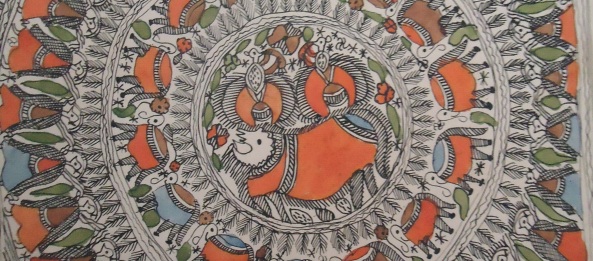Madhubani is a form of painting that originated in the Mithila district of Bihar state in India. As an art form, it is believed to be nearly 3000 years old. Traditionally this form of painting was undertaken solely by women to decorate the walls and floors of their village huts. The greatest efforts were spent in decorating the ‘kobbar ghar’ or the nuptial chambers for the newly wedded bride and groom to enjoy.
The walls were first prepared by plastering them in cowdung, after which they were white washed and then covered in rice paste. The main parts of the paintings were often given to the most talented painter. However everyone, apart from the men, played a part in decorating different areas of the walls. Paintings were often painted in a centrifugal way – starting from the centre and then moving outwards.
The paint was made from locally available plants and roots. In his book on the history of Indian paintings, Krishna Chaitanya explains how the dyes were obtained. Blooms of the ‘Kusum’, which is found growing in the wild grass, provided the scarlet colour. Kusum, when left to darken, turns to a deep Sienna. The juice of the banana leaf mixed with lime and milk gave a soft gold dye. Turmeric was used for a dark yellow shade. Smoke captured from the charcoal fire gave a rich black. Flowers from the ‘Palasa’ plant were often used for yellow, while green was obtained from certain climbers. The binding agent for the paints was made from goat’s milk mixed with the gum from the ‘Babool’ tree. A sharpened twig of bamboo served as the brush and rags of cloth were used to colour larger areas. Because the paints were freshly made, the paintings acquired a unique radiance.
Nowadays these paintings have acquired a commercial aspect and are now done on paper with chemical paints being commonly used. It was during one of the exhibitions on handicrafts in India, that I first came across the Madhubani paintings. I hadn’t come across this style of art before and liked the combination of strong colours and intricate designs. The photos shown are of the paintings that I purchased. Unfortunately this traditional art form is no longer used to decorate the walls in Mithila. Otherwise how amazing it would have been to see the walls of a hut covered with these radiant designs – all done to welcome a new bride.


Nice Article on Mithila/ Madhubani Paintings.
Few updates to your info.
Madhubani is a district in the Mithila region in Bihar. Although traditionally known as the Mithila Paintings , after commercialization it has become popular as the Madhubani Paintings since commercialization began from Madhubani district.
These paintings are not only limited to Kobra Ghar and Marriages but are for all occasions in a life cycle to all the festivals.
And still in Maithil marriages and other rituals the paintings are made where ever Maithils are across the globe.
You might find painted huts in the villages since now huts are far too few even in villages. but still during occasions the concrete houses are decorated with paintings.
Thanks a lot for the extra input Nupur. That’s a lovely blog that you have as well.
your slide show with paintings is wonderful!
Nice post of Indian art! Sharing you an Indian woman artist’s idea – http://wp.me/p3bwN9-by
Really cool! Thanks.
A friend of mine suggested I take a look at this blog because of the varied travel experiences. This was a wonderful post on Madhubani paintings. They are an exceptional craft, and interestingly enough is taught by mothers to daughters. The colors are really vibrant and the imagery has such deep meaning. Its unfortunate that commercialization and commodification has afflicted this folk art. I’ve actually been to Madhubani (did thesis work there), and have seen women collectives makes these paintings. While a source of income, its kind of disheartening to see an almost factory like setting pumping out artwork for sale…but such is life…we can’t have it both ways as they’ve got as much of a right to make a living as we do!
Excellent posts; keep up the good work, and keep on traveling. I’m certain all your followers are living vicariously through your posts!
Thanks for taking the time to read. I would love to go to Madhubani some day. Agree with what you say about commodification and commercialization, however, if that keeps the art alive and prevents it from ‘fading out’ then I’m all for it, provided that it is the artists that get the majority of the share from the sales. I try and buy these works of arts at Government organised exhibitions in India where you can buy these directly from the artists.